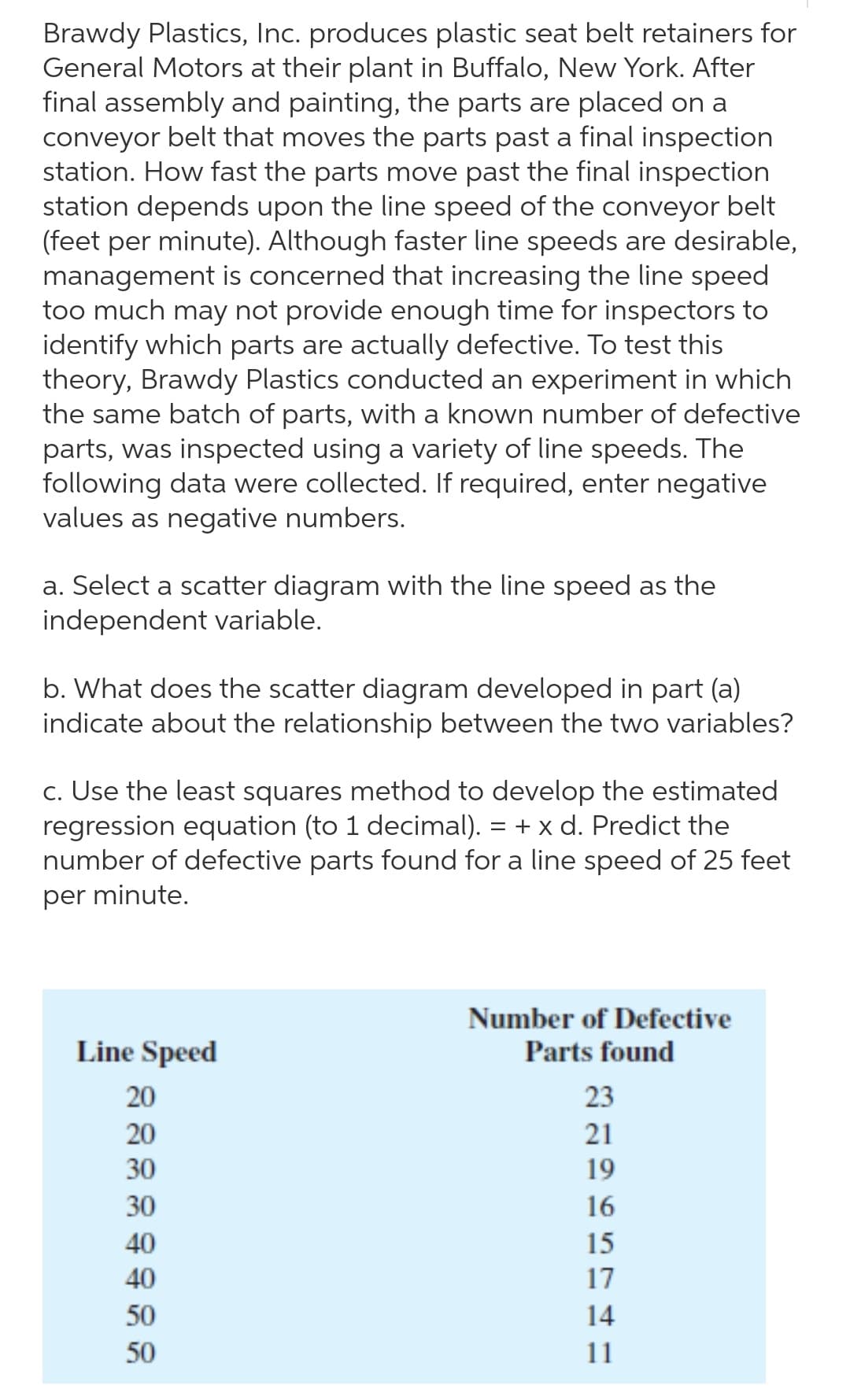Brawdy Plastics, Inc. produces plastic seat belt retainers for General Motors at their plant in Buffalo, New York. After final assembly and painting, the parts are placed on a belt that moves the parts past a final inspection conveyor station. How fast the parts move past the final inspection station depends upon the line speed of the conveyor belt (feet per minute). Although faster line speeds are desirable, management is concerned that increasing the line speed too much may not provide enough time for inspectors to identify which parts are actually defective. To test this theory, Brawdy Plastics conducted an experiment in which the same batch of parts, with a known number of defective parts, was inspected using a variety of line speeds. The following data were collected. If required, enter negative values as negative numbers. a. Select a scatter diagram with the line speed as the independent variable. b. What does the scatter diagram developed in part (a) indicate about the relationship between the two variables? c. Use the least squares method to develop the estimated regression equation (to 1 decimal). = + x d. Predict the number of defective parts found for a line speed of 25 feet per minute. Number of Defective Parts found Line Speed 20 23 20 21 30 19 30 16 40 15 40 17 50 14 50 11
Brawdy Plastics, Inc. produces plastic seat belt retainers for General Motors at their plant in Buffalo, New York. After final assembly and painting, the parts are placed on a belt that moves the parts past a final inspection conveyor station. How fast the parts move past the final inspection station depends upon the line speed of the conveyor belt (feet per minute). Although faster line speeds are desirable, management is concerned that increasing the line speed too much may not provide enough time for inspectors to identify which parts are actually defective. To test this theory, Brawdy Plastics conducted an experiment in which the same batch of parts, with a known number of defective parts, was inspected using a variety of line speeds. The following data were collected. If required, enter negative values as negative numbers. a. Select a scatter diagram with the line speed as the independent variable. b. What does the scatter diagram developed in part (a) indicate about the relationship between the two variables? c. Use the least squares method to develop the estimated regression equation (to 1 decimal). = + x d. Predict the number of defective parts found for a line speed of 25 feet per minute. Number of Defective Parts found Line Speed 20 23 20 21 30 19 30 16 40 15 40 17 50 14 50 11
College Algebra (MindTap Course List)
12th Edition
ISBN:9781305652231
Author:R. David Gustafson, Jeff Hughes
Publisher:R. David Gustafson, Jeff Hughes
Chapter6: Linear Systems
Section6.8: Linear Programming
Problem 5SC: If during the following year it is predicted that each comedy skit will generate 30 thousand and...
Related questions
Topic Video
Question
I WANT EXCEL SOLUTION

Transcribed Image Text:Brawdy Plastics, Inc. produces plastic seat belt retainers for
General Motors at their plant in Buffalo, New York. After
final assembly and painting, the parts are placed on a
conveyor belt that moves the parts past a final inspection
station. How fast the parts move past the final inspection
station depends upon the line speed of the conveyor belt
(feet per minute). Although faster line speeds are desirable,
management is concerned that increasing the line speed
too much may not provide enough time for inspectors to
identify which parts are actually defective. To test this
theory, Brawdy Plastics conducted an experiment in which
the same batch of parts, with a known number of defective
parts, was inspected using a variety of line speeds. The
following data were collected. If required, enter negative
values as negative numbers.
a. Select a scatter diagram with the line speed as the
independent variable.
b. What does the scatter diagram developed in part (a)
indicate about the relationship between the two variables?
c. Use the least squares method to develop the estimated
regression equation (to 1 decimal). = + x d. Predict the
number of defective parts found for a line speed of 25 feet
per minute.
Number of Defective
Line Speed
Parts found
20
23
20
21
30
19
30
16
40
15
40
17
50
14
50
11
Expert Solution
This question has been solved!
Explore an expertly crafted, step-by-step solution for a thorough understanding of key concepts.
This is a popular solution!
Trending now
This is a popular solution!
Step by step
Solved in 4 steps with 2 images

Knowledge Booster
Learn more about
Need a deep-dive on the concept behind this application? Look no further. Learn more about this topic, statistics and related others by exploring similar questions and additional content below.Recommended textbooks for you

College Algebra (MindTap Course List)
Algebra
ISBN:
9781305652231
Author:
R. David Gustafson, Jeff Hughes
Publisher:
Cengage Learning

Algebra for College Students
Algebra
ISBN:
9781285195780
Author:
Jerome E. Kaufmann, Karen L. Schwitters
Publisher:
Cengage Learning

Elementary Geometry For College Students, 7e
Geometry
ISBN:
9781337614085
Author:
Alexander, Daniel C.; Koeberlein, Geralyn M.
Publisher:
Cengage,

College Algebra (MindTap Course List)
Algebra
ISBN:
9781305652231
Author:
R. David Gustafson, Jeff Hughes
Publisher:
Cengage Learning

Algebra for College Students
Algebra
ISBN:
9781285195780
Author:
Jerome E. Kaufmann, Karen L. Schwitters
Publisher:
Cengage Learning

Elementary Geometry For College Students, 7e
Geometry
ISBN:
9781337614085
Author:
Alexander, Daniel C.; Koeberlein, Geralyn M.
Publisher:
Cengage,

Trigonometry (MindTap Course List)
Trigonometry
ISBN:
9781337278461
Author:
Ron Larson
Publisher:
Cengage Learning

Glencoe Algebra 1, Student Edition, 9780079039897…
Algebra
ISBN:
9780079039897
Author:
Carter
Publisher:
McGraw Hill